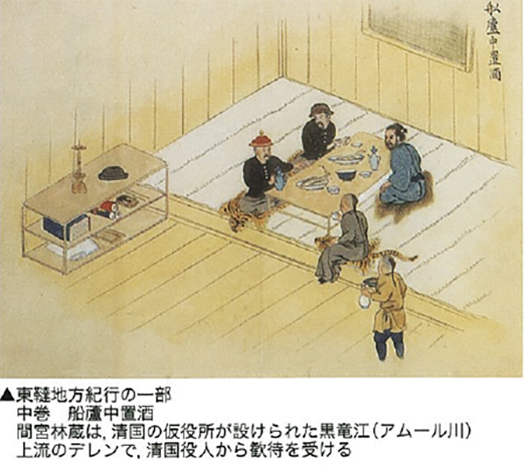


間宮林蔵たち幕末期の領土測量探求者の営為の上に立って、黒田清隆などの新政府は北海道島の日本支配をより強固なものとしていくために積極的な「殖民」政策を大方針として立てていく。
その基盤として「寒冷地仕様住宅」の研究とその普及政策があった。そしてそのDNAは今日の地域自治体・北海道にも脈々と受け継がれ、高断熱高気密住宅として完全に地域に根付き、さらに現在、本州以南地域の住宅革新にも波及している。住宅を巡る日本史としては歴史の一本道であるように思われる。
間宮林蔵は本来の任務であった樺太探検のあと、現地の人びとの協力を得て、黒竜江(アムール川)中流の交易都市・デレン探訪に向かう。かれ30才の当時。その様子はこの第2回樺太探査の記録としてまとめられた「東韃地方紀行」に記述されている。今に伝わる絵画表現は、間宮林蔵の探検者としての師・村上島之允(しまのじょう)の子・貞助が編纂者として記録されている。貞助の絵画表現が1810年当時のこの地域の状況をわかりやすく伝えてくれる。伝統的な「大和絵」の臨場表現として軍記物や洛中洛外図などと同様にナナメ上方からの視点で情報が描かれていて、わかりやすい。
デレンには清朝の出先機関が置かれて「朝貢」がタテマエでの交易活動が行われている実相が伝わってくる。1枚目の絵図では清朝に対して異民族が服従し上納する形式が表されている。もちろん返礼品が対応
されることが前提。異民族側からすると目的は交易だけであるけれど、自分が世界の中心であるとする中華思想としてはこういう「形式」を求めるものなのだろう。現代にも繋がる部分か。
一方で形式が終われば、いわゆる客人としての接遇が間宮に対して行われ、酒席での接待が行われた様子も表現されている。そして、交易された品々はデレンの市で取引されて自由に流通していた様子も見て取れる。このような市場のありよう、形式としては清朝が地域「支配」していたことになるのかどうか。
この段階の日本・江戸幕府は欧米世界との対応の中で、世界標準の「近代国家」という概念に対応する姿勢を見せているし、この間宮たちの行動はそういった実態を表している。その後の極東アジア情勢の推移は清朝国家が破綻していく一方、日本は「脱亜入欧」を目指していくことになる。

間宮の視線は庶民の暮らしぶりにも向けられている。現地の人びとの子育ての様子までもが表現されていた。デレンの役人たちとは友好的に接することができた証しか。絵は乳児の「ゆりかご」の様子のように判別できる。妻帯せず、子をなさなかった間宮はどう感じたのか、ふとかれの両親のことを思い出す瞬間もあっただろう。国事に身を投じた人生とは言え、やや切なさも感じる。
English version⬇
Diplomacy at the End of the Edo Period at Deren in the Middle Heilongjiang River – Mamiya Rinzo’s Birthplace – 8
Diplomacy between Japan and China at the time of 1810 at the Qing dynasty’s outpost in China. Under the isolationist regime, was it in the form of an accidental encounter with a local in Sakhalin accompanying a local in Sakhalin? …
Based on the efforts of Mamiya Rinzo and other territorial surveyors at the end of the Edo period, the new government, led by Kuroda Kiyotaka, adopted an aggressive “colonization” policy to consolidate Japanese control over Hokkaido Island.
The foundation for this policy was research into “cold-weather housing” and the policy to promote its spread. This DNA has been passed down through the generations to today’s local governments in Hokkaido, where highly insulated and airtight housing has taken root, and is now spreading to housing innovations in the south of Honshu and beyond. It seems to be a straight line of history as far as Japanese history concerning housing is concerned.
After his original mission to explore Sakhalin, Rinzo Mamiya, with the cooperation of the local people, went to explore the trading city of Deren in the middle reaches of the Heilongjiang River (Amur River). He was 30 years old at the time. The account of his expedition is described in the book “Travels in the East Rhodesian Region,” which was compiled as a record of the second Sakhalin expedition. The pictorial representations handed down to this day are recorded by Sadasuke, the son of Mamiya Rinzo’s mentor as an explorer, Murakami Shimanojo, as the compiler of the book. Sadasuke’s pictorial representation conveys the situation of this region at the time of 1810 in an easy-to-understand manner. The information is depicted from a naname-upper perspective as in the traditional “Yamato-e” realistic expression, as in military records and Rakuchu-Rakugai-zu, and is easy to understand.
The first picture depicts the form of subjugation and payment of tribute by different ethnic groups to the Qing dynasty. Of course, it is a prerequisite that the return gift
The first illustration shows a form of subjugation and payment to the Qing Dynasty by the different ethnic groups. From the perspective of the different ethnic groups, the purpose is only to trade, but the Chinese thought that they are the center of the world requires this kind of “formality”. Is this a part of the modern world as well?
On the other hand, once the formalities were over, Mamiya was treated as a so-called guest, and the scene of entertainment at the drinking table is also expressed. We can also see how traded goods were traded and freely distributed at the market in Deren. The question is whether or not the Qing dynasty “ruled” the region in the form of this kind of market.
The Japanese Edo shogunate at this stage in its dealings with the Western world was taking a stance that corresponded to the concept of a world-standard “modern state,” and the actions of these Mamiya and others represent such a reality. The subsequent transition of the situation in Far East Asia would see the collapse of the Qing dynasty state, while Japan would aim for “de-industrialization” of Europe.
Mamiya’s gaze also turned to the way of life of ordinary people. He even described how the local people were raising their children. Is this a sign that he was able to have friendly contact with the officials in Deren? The paintings can be identified as showing the “cradle” of an infant. Mamiya, who was not married and had no children, must have felt how he felt, and there must have been moments when he thought of his parents. Although Mamiya’s life was devoted to the affairs of the country, it is also somewhat sad.
Posted on 5月 23rd, 2023 by 三木 奎吾
Filed under: 未分類







コメントを投稿
「※誹謗中傷や、悪意のある書き込み、営利目的などのコメントを防ぐために、投稿された全てのコメントは一時的に保留されますのでご了承ください。」
You must be logged in to post a comment.